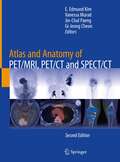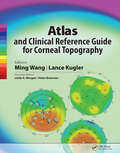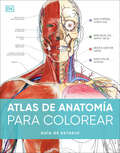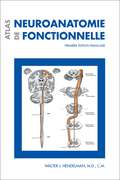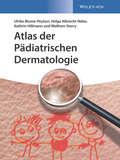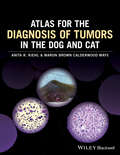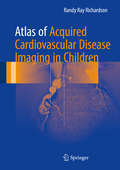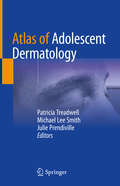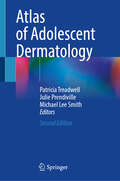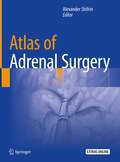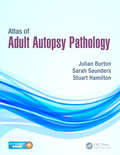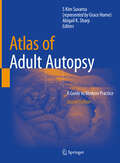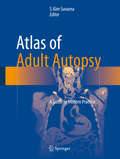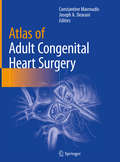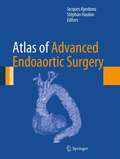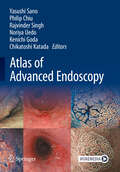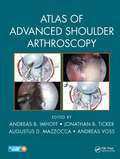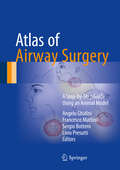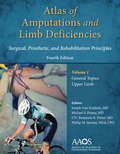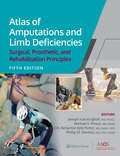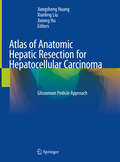- Table View
- List View
Atlas and Anatomy of PET/MRI, PET/CT and SPECT/CT
by E. Edmund Kim Vanessa Murad Jin-Chul Paeng Gi-Jeong CheonThis atlas showcases cross-sectional anatomy for the proper interpretation of images generated from PET/MRI, PET/CT, and SPECT/CT applications. Hybrid imaging is at the forefront of nuclear and molecular imaging and enhances data acquisition for the purposes of diagnosis and treatment. Simultaneous evaluation of anatomic and metabolic information about normal and abnormal processes addresses complex clinical questions and raises the level of confidence of the scan interpretation. Extensively illustrated with high-resolution PET/MRI, PET/CT and SPECT/CT images, this atlas provides precise morphologic information for the whole body as well as for specific regions such as the head and neck, abdomen, and musculoskeletal system. Atlas and Anatomy of PET/MRI, PET/CT, AND SPECT/CT, Second Edition is a unique resource for physicians and residents in nuclear medicine, radiology, oncology, neurology, and cardiology.
Atlas and Clinical Reference Guide for Corneal Topography
by Ming Wang Lance KuglerCorneal topography has become essentially a pattern recognition trade, best learned by viewing multiple images of representative patterns. In spite of this, currently available topography books focus only on the technology behind topography, or a particular application of topography, as opposed to presenting a comprehensive collection of topographic patterns that provide quick, consistent pattern recognition and identification. Drs. Wang and Kugler, along with Drs. Morgan and Boerman, look to fill this void with Atlas and Clinical Reference Guide for Corneal Topography.Atlas and Clinical Reference Guide for Corneal Topography is the first corneal topography book that lends itself to efficient image search and reference for busy clinicians at chair side. Organized into both map-based and disease-based sections, the book allows for quick reference in busy clinical situations. Images come from the commonly used topographers, the Zeiss Atlas and the Oculus Pentacam, but the principles of pattern recognition can be applied to any topographer. Due to the text’s large collection of topographic images and corresponding corneal conditions, Atlas and Clinical Reference Guide for Corneal Topography can be used side by side with the topographer.Designed as both a learning tool for students and a reference for clinicians to use when faced with a challenging topography interpretation, Atlas and Clinical Reference Guide for Corneal Topography will be appreciated by a wide spectrum of eye care professionals. General ophthalmologists, cataract and refractive surgeons, corneal specialists, optometrists, and ophthalmology residents and students will benefit from this invaluable atlas for corneal topography.
Atlas de anatomía para colorear (The Human Body Coloring Book): Guía de estudio
by DKEl recurso perfecto para que los estudiantes y expertos en medicina amplíen sus conocimientos de anatomía.Este libro de anatomía para colorear te ayuda a estudiar de una forma diferente, relajante y divertida. Aprende y memoriza con facilidad toda la información sobre la anatomía humana mientras desconectas y potencias tu creatividad con más de 200 dibujos en blanco y negro repletos de detalles para colorear. Con información de las diferentes partes del cuerpo humano y sus funciones.Incluye todos los tejidos, órganos, aparatos y estructuras del cuerpo, desde las minúsculas células hasta los sistemas más complejosCada página contiene una leyenda que te indica qué parte del cuerpo humano colorear y con qué número se corresponde. ¡No las mires si quieres ejercitar tu memoria! Puedes usarlas para comprobar si tus respuestas son correctas.¡Ponle nombre a cada una de las partes del cuerpo humano, coloréalas y aprende todo el vocabulario anatómico en español que necesitas para superar tus exámenes con éxito!Y si quieres seguir aprendiendo, complementa tus estudios de anatomía con El gran libro del cuerpo humano, la guía definitiva para conocer el funcionamiento del cuerpo a fondo, a través de ilustraciones en 3D e imagenología médica.Studying the human body is easy with this interactive biology colouring book! Color and label anatomical diagrams to learn and recall everything there’s to know about the human body. This drawing book helps you understand human anatomy while giving you the opportunity to learn, understand and remember information with ease! This biology study guide is a wonderful way to learn about the parts and systems of the human body! Inside, you’ll find:More than 200 highly detailed anatomical drawings to colorCrystal clear instructions that explain exactly what is required of each artworkComprehensive coverage of the human body and from cell to systemDiscover the human body by naming each part and coloring it! Filled with black and white line artwork, this anatomy coloring book helps you study anatomical illustrations in an interactive and fun way. The biology coloring guide gives clear instructions on what needs to be colored and which colors to use. Then you are left to color and label the parts and systems of the body while improving your knowledge of human anatomy.
Atlas de neuroanatomie fonctionnelle: Première édition française
by Walter J. HendelmanL’Atlas de neuroanatomie fonctionnelle constitue le manuel incontournable pour les étudiants en médecine et les neurosciences de même que pour les médecins résidents qui débutent le programme de spécialisation en neurologie, neurochirurgie ou autres domaines connexes. L’Atlas présente toute l’information essentielle sur l’organisation du système nerveux central (SNC), permettant d’acquérir une bonne compréhension du SNC d’un point de vue fonctionnel. Les aspects cliniques sont présentés de manière à établir une relation entre les structures du cerveau et les patients qui présentent des pathologies neurologiques. Les nombreuses illustrations des divisions anatomiques du SNC sont accompagnées de notes sur le rôle que joue chacune dans le fonctionnement du cerveau. Les images neuroradiologiques (tomodensitométrie et IRM) font le pont entre l’information neuroanatomique et l’examen clinique du cerveau. L’Atlas offre également un glossaire de termes anatomiques et cliniques, de même qu’une bibliographie annotée qui offrent des pistes vers d’autres documents de référence, tant du point de vue des sciences fondamentales que clinique. Paru en anglais en 2006 et en italien en 2009, l’Atlas de neuroanatomie fonctionnelle, 2e édition, est offert pour la première fois en français. L’Atlas de neuroanatomie fonctionnelle offre : un guide visuel et textuel du système nerveux central (SNC), agrémenté de photos du cerveau et d’illustrations en couleur ; des renseignements présentés dans un format qui favorise une compréhension approfondie des concepts complexes de la neuroanatomie ; chaque illustration s’accompagne d’un texte explicatif ; des renseignements neuroanatomiques exhaustifs permettant de bien comprendre le SNC humain du point de vue fonctionnel ; les aspects cliniques, ce qui complète l’ouvrage. http://www.atlasbrain.com/Publié en français
Atlas der Pädiatrischen Dermatologie
by Wolfram Sterry Ulrike Blume-Peytavi Helga Albrecht-Nebe Kathrin HillmannDieser Atlas verbindet als erster die beiden wichtigen Themengebiete der Pädiatrie und Dermatologie. Da sich das Erscheinungsbild von Hauterkrankungen in der Kindheit stark von dem im Erwachsenenalter unterscheiden kann, stellt dieses einzigartige Nachschlagewerk eine wichtige Quelle sowohl für Dermatologen als auch Pädiater dar. Der Schwerpunkt der Diagnostik von Hauterkrankungen beim Kind liegt insbesondere auf der morphologischen Befunderhebung und ihrer lokalisations- und altersabhängigen Manifestation. Ist die exakte klinische Beurteilung und differenzialdiagnostische Abgrenzung erfolgt, kann sie dem Kind häufig invasive Eingriffe zur Diagnosefindung ersparen. Hier setzt der vorliegende Atlas an. Jahrzehntelange klinische Erfahrung der drei Autoren findet in diesem Atlas ihren Ausdruck. Er lebt von seinen Abbildungen, die ihn zu einem einzigartigen Nachschlagewerk machen, das schnell den diagnostischen Blick trainiert und schult. Exzellent und umfangreich bebildert mit genauen Befundbeschreibungen und ausführlichen Differenzialdiagnosen versehen, führt der Atlas schnell von den Hauptmerkmalen, über diagnostische Kriterien, sicher und einfach zur Diagnose und sollte somit in keiner Praxis fehlen.
Atlas der unerwünschten Ergebnisse in der Chirurgie von Lippen-Kiefer-Gaumenspalten: Ein fallbasierter Leitfaden zur Vorbeugung und Behandlung von Komplikationen
by Percy Rossell-PerryDieses Buch umfasst Diagnostik, Behandlung und Vorbeugung von unerwünschten Ergebnissen und Komplikationen im Zusammenhang mit Lippen-Kiefer-Gaumenspalten-Operationen. Illustriert mit mehr als 200 Bildern und basierend auf der 25-jährigen Erfahrung des Herausgebers, umfasst das Werk das gesamte Spektrum der Komplikationen anhand von Fallbeispielen sowie Management- und Präventionsprotokollen. Aufgeteilt in neun didaktische Teile, werden in den Kapiteln Komplikationen im Zusammenhang mit Anästhesie, Lippenasymmetrie, Narbenstörungen, postoperative Dehiszenz, sekundäre Nasendeformitäten sowie dentoskelettale Folgen vorgestellt. Der "Atlas der unerwünschten Ergebnisse in der Chirurgie der LIppen-Kiefer-Gaumenspalten" ist geeignet für plastische Chirurgen, Kinderchirurgen, HNO-Ärzte, Kiefer- und Gesichtschirurgen, Kopf- und Halschirurgen, Zahnärzte und Anästhesisten.
Atlas for the Diagnosis of Tumors in the Dog and Cat
by Anita R. Kiehl Maron Brown Calderwood MaysAtlas for the Diagnosis of Tumors in the Dog and Cat is a diagnostic tool for determining if samples are abnormal and defining the cause of the abnormality, with 386 clinical images depicting normal and abnormal results, the book begins by describing specific types of neoplasia. Offers a brief overview of the methods used to produce a diagnosis and prognosis from a biopsy tissue sample Pairs photographs of biopsy samples with photomicrographs of cells obtained via fine needle aspirate Includes a useful chapter covering sample handling, staining, and shipping
Atlas of 3D Transesophageal Echocardiography in Structural Heart Disease Interventions: Cases And Videos
by Wei-Hsian Yin Ming-Chon Hsiung Fang-Chieh Lee Wei-Hsuan ChiangUses over 500 to demonstrate various cardiovascular pathologies.<P><P> All of the delicate pictures were captured, reconstructed, and analysed by well-experienced senior physicians and cardiovascular imaging specialists.<P> All 40 cases are written in the uniform structure and easily readable way.<P>This book introduces classic and unique cases in 3D TEE in structural heart disease interventions. In each all the 40 cases, background information, clinical presentations, and diagnostic findings are present and followed by step-by-step approaches of interventional therapies and outcomes after the procedures. The highlight of the book is to utilize extensive illustrations, over 500, to demonstrate various cardiovascular pathologies. Most of the figures are 3D transesophageal echocardiograms, they are cooperated with 2D transesophageal echocardiograms, X rays, fluoroscopies, computed tomograms, etc. Since the echo images obtained in clinic practice are moving images, it also includes over 300 videos, which serve as a supplement to the static illustrations in this book.<P> The atlas is organized into five chapters. In Chapters one, cases received closure of congenital and acquired cardiac defects are described. Transcatheter aortic valve implantation and its complications are discussed in Chapter two and three. Chapter four details the valve-in-valve therapy. Chapter five covers MitraClip therapy. It offers readers an insider’s view of 3D transesophageal echocardiography in structural heart disease interventions and to refresh their clinical work.
Atlas of Acquired Cardiovascular Disease Imaging in Children
by Randy Ray RichardsonThis atlas is a concise visual guide to the imaging of acquired heart disease in infants, children, and adolescents. Imaging plays an ever-increasing vital role in diagnosis, preoperative planning, and postoperative management for children with these disorders. The book reviews techniques for lowering radiation, discusses protocols for imaging in children, and provides recommendations for the most appropriate studies that decrease the time and cost of imaging these patients. Focusing on functional and anatomic imaging with an emphasis on three-dimensional color-coded models derived from CT and MR scans, this book promotes understanding of cardiovascular disorders in children, including infectious, neoplastic, and metabolic diseases. Atlas of Acquired Cardiovascular Disease Imaging in Children is a valuable resource through which cardiologists, radiologists, pediatric cardiothoracic surgeons, and residents can improve the quality and treatment of pediatric and adolescent patients with acquired heart disease.
Atlas of Adolescent Dermatology
by Patricia Treadwell Michael Lee Smith Julie PrendivilleValuable to dermatologists, adolescent medicine specialists, family medicine practitioners, and primary care physicians, the Atlas of Adolescent Dermatology presents a concise and practical guide to the diagnosis and management of adolescent skin diseases. Each chapter follows a similar format, to assist in ease of reference, and contains information on diagnosis and management. The various chapters include conditions such as Acne, Seborrheic Dermatitis, Eczema, Scabies, Contact Dermatitis, and selected Genodermatoses.
Atlas of Adolescent Dermatology
by Patricia Treadwell Michael Lee Smith Julie PrendivilleThe field of adolescent dermatology is a growing topic amongst pediatricians and adolescent medicine providers. There are numerous conditions specific to the adolescent population that require specialized care. This book details the diagnosis and management of a variety of adolescent skin diseases. The text is organized into eight different sections. The first section describes the most common conditions seen in the adolescent population, acne and perioral dermatitis. Sections two and three cover cutaneous infections and infestations and eczematous papulosquamous issues. The fourth section focuses on autoimmune and rheumatologic conditions while part five provides reactions to external causes. The final three sections detail genodermatoses and genetic conditions in dermatology, tumors and nodular lesions and lymphocytic disorders. Since publication of the previous edition, there have been several important developments in the field. One major issue that was not addressed is skin cancer in adolescents. Due to tanning beds and other factors, the prevalence of skin cancer in adolescents is rising. Various diagnoses and managements are addressed. Infections from body art such as tattoos and piercings is also a hot topic that has been added. The number of youths getting tattoos and piercings has also risen and subsequently so have complications from them. Now fully revised and expanded. The Atlas of Adolescent Dermatology is a valuable resource for dermatologists, adolescent medicine specialists, family medicine practitioners, and primary care physicians.
Atlas of Adrenal Surgery
by Alexander ShifrinThis atlas is designed to present a comprehensive and state-of the-art approach to single surgical procedure - adrenal glands surgery. The idea of this surgical atlas is to bring expertise of adrenal surgery to all surgeons performing, or learning how to perform successful adrenalectomy procedure, and to illustrate different techniques of adrenalectomy that are performed by different renown surgeons. The atlas illustrates several different approaches to adrenalectomy, which include more commonly used anterior lateral adrenalectomy and more advanced newer techniques of posterior retroperitoneoscopic and robotic adrenalectomies. This atlas emphasizes different approaches and ways to perform the same procedure. Specifically how the same procedure could be successfully completed by different surgeons with specific details of each technique. Each approach is presented by three different expert-surgeons illustrating three different techniques of procedure, including single-site approach. Different surgeons have different “tricks” on how to perform this type of procedure successfully. Each chapter presents procedures that are performed and illustrated by a different single surgeon. All authors are members of American Association of Endocrine Surgeons (AAES) and are experts in this specific technique. This atlas includes 18 chapters and illustrates traditional open approach, anterior lateral right and left adrenalectomy approaches, and more advanced state-of the-art posterior retroperitoneoscopic right and left adrenalectomies (including single port procedure) and robotic adrenalectomies. The text includes extensive illustrations and links to video of all procedures making this an interactive text. <P><P> Atlas of Adrenal Surgery represents the first single source to provide information on technique and outcomes for a diversity of endocrine surgeons, minimally invasive laparoscopic surgeons, surgical oncologists, urologists and general surgeons.
Atlas of Adult Autopsy Pathology
by Stuart Hamilton Julian Burton Sarah SaundersThe Atlas of Adult Autopsy Pathology is a full-color atlas for those performing, or learning to perform, adult autopsies. It is arranged by organ systems and also includes chapters on external examination findings, the effect of decomposition, and histopathological findings, as well as procedures and devices one may encounter during autopsy.The boo
Atlas of Adult Autopsy: A Guide to Modern Practice
by S. Kim Suvarna Abigail K. SharpThis new second edition of the successful 2016 Atlas of Adult Autopsy Practice is fully updated and refreshed with novel illustrations, and data refinements. It leads with pictures, focused text, and commentary on the autopsy itself as a specialist pathology subject. The content expands the coverage of specialist techniques with chapters covering post-mortem imaging, toxicology, neuropathology and forensic pathology from practising specialists. The addition of an original chapter addressing post-mortem histology adeptly contributes to the autopsy training literature. The book – a mainstay for the numerous practitioners working in this field, provides a standard for autopsy practice in the UK, Europe and beyond.
Atlas of Adult Autopsy: A Guide to Modern Practice
by S. Kim SuvarnaThisatlas leads the reader through the adult autopsy process, and its commonvariations, with a large number of high-quality macroscopic photographs andconcise accompanying text. It provides a manual of current practice and is aneasy-to-use resource for case examination for consent, medico-legal andradiological autopsies. Externalrealities and checks are discussed at the beginning of the book, which goes onto cover specific body cavities and organ systems in detail. The book ends withchapters on topics including forensic autopsies, specialist sampling, toxicologyanalyses and the radiological autopsy. Atlasof Adult Autopsy is aimed at practicing pathologists, particularly those intraining grades. It may also be of interest to anatomical technicians inautopsy suites, as well as parties with a legal interest in autopsy practice.
Atlas of Adult Congenital Heart Surgery
by Constantine Mavroudis Joseph A. DearaniThis atlas comprehensively covers surgical techniques for congenital heart surgery. As the population with congenital heart defects increases more and more operations will be required to treat the residual defects, new defects, and replacement strategies such as valve replacements. Chapters are devoted to specific conditions and feature detailed descriptions of how to perform a variety of appropriate reparative surgical techniques; involving complex anatomy, reoperative surgery, and unique techniques to this speciality, enabling the reader to develop a deep understanding of how to successfully resolve situations such as left ventricular outflow tract obstruction, anomalous pulmonary venous return, and anomalous origin of the coronary arteries. Atlas of Adult Congenital Heart Surgery provides a foundational resource for practising and trainee cardiac surgeons, nurses, and healthcare associates seeking specialist training and insight to the resolution of congenital heart diseases in adults.
Atlas of Advanced Endoaortic Surgery
by Stéphan Haulon Jacques KpodonuThere is no standard textbook at this time on endovascular management of thoracic aortic pathologies. Atlas of Thoracic Aortic Endografting contains clinical case scenarios as well as controversies to highlight the use of this new technology. The various aortic pathologies are discussed, combining etiology, diagnostic tools like intravascular ultrasound (IVUS) and 64 slice CT scans which are all state of the art technologies, endovascular treatment, management of endoleaks, reinterventions combined with techniques of trouble shooting. This book highlights the new changes in the management of thoracic aortic diseases.
Atlas of Advanced Endoscopy
by Yasushi Sano Noriya Uedo Rajvinder Singh Philip Chiu Kenichi Goda Chikatoshi KatadaThis comprehensive book features high-quality images, videos, and step-by-step instructions for capturing detailed views of the upper and lower gastrointestinal tract from the oral cavity to the anus. In addition to covering areas such as the tongue, head and neck, non-Barrett's esophagus, Barrett's esophagus, stomach, duodenum, colon, and rectum, the atlas is authored by leading GI experts from the Asian Novel Bio-Imaging and Intervention Group in the Asia-Pacific region, known for their unparalleled expertise and commitment to excellence. The book covers various aspects, including equipment reviews and diagnostic technologies using the latest unified global standard system. It explains techniques such as high-definition endoscopy, magnifying endoscopy, chromoendoscopy, NBI, TXI, RDI, and AI, while also providing insight into classifications such as the Japan Esophageal Society Classification, the VS Classification/MESDA-G, and the JNET Classification. Each case section provides expert analysis and notable endoscopic images, accompanied by histopathologic images depicting various benign lesions and early cancers. The Atlas of Advanced Endoscopy serves as an invaluable resource to enhance the reader's knowledge and understanding of the complexities of gastrointestinal endoscopy. It is designed to help practitioners, clinicians, gastroenterologists, and medical students learn diagnostic strategies, procedures, and clinically significant cases. We hope this atlas will always be at your side in the endoscopy room.
Atlas of Advanced Shoulder Arthroscopy
by Andreas B. Imhoff, Jonathan B. Ticker, Augustus D. Mazzocca and Andreas VossArthroscopic surgery has been one of the biggest Orthopedic advances in the last century. It affects people of all ages. Total joint replacement may capture popular imagination, but arthroscopy continues to have a greater effect on more people. This Atlas provides the most up to date resource of advanced arthroscopic techniques, as well as including all the standard procedures. Beautifully illustrated and supported by online videos of the latest techniques, this Atlas will appeal to both experienced shoulder surgeons as well as the orthopedic surgeon seeking to enhance his or her knowledge of shoulder arthroscopy.
Atlas of Advanced Shoulder Arthroscopy
by Andreas Voss Augustus Mazzocca Andreas Imhoff Jonathan TickerArthroscopic surgery has been one of the biggest Orthopedic advances in the last century. It affects people of all ages. Total joint replacement may capture popular imagination, but arthroscopy continues to have a greater effect on more people. This Atlas provides the most up to date resource of advanced arthroscopic techniques, as well as including all the standard procedures. Beautifully illustrated and supported by online videos of the latest techniques, this Atlas will appeal to both experienced shoulder surgeons as well as the orthopedic surgeon seeking to enhance his or her knowledge of shoulder arthroscopy.
Atlas of Airway Surgery: A Step-by-Step Guide Using an Animal Model
by Livio Presutti Francesco Mattioli Angelo Ghidini Sergio BotteroThis superbly illustrated atlas provides step-by-step descriptions of surgical procedures to the airways based on use of the sheep as an animal model, which has been demonstrated scientifically to be comparable to the human. The procedures covered - tracheotomy, laryngotracheoplasty, slide tracheoplasty, tracheal reconstruction, partial cricotracheal reconstruction, and main endoscopic techniques - are relevant to a range of frequent surgical indications, such as stenosis, laryngotracheomalacia, and tracheal tumor. The book is the first to describe such surgery on the basis of this animal model and includes a full description of preparation of the model. The practical guidance provided will equip surgical trainees with the knowledge required before embarking on these procedures in humans, but will also be highly relevant to more experienced surgeons wishing to upgrade their skills. The book is the outcome of a successful collaboration between the Head and Neck Surgery Departments of the University Hospital of Modena and the Bambino Ges#65533; Hospital in Rome.
Atlas of Alzheimer's Disease
by Howard FeldmanThe last 20 years have brought unprecedented new knowledge to our understanding of Alzheimer's disease (AD) and for the first time, approved symptomatic treatments. Authored by one of the world's leading authorities on the management of AD and related dementias, this highly illustrated Atlas of Alzheimer's Disease describes the colorful history of
Atlas of Amputations & Limb Deficiencies, 4th edition
by J. Ivan Krajbich Michael S. Pinzur Benjamin K. Potter Phillip M. Stevens, Med, CPOThe leading and definitive reference on the surgical and prosthetic management of acquired and congenital limb loss. The fourth edition of the Atlas of Amputations and Limb Deficiencies is written by recognized experts in the fields of amputation surgery, rehabilitation, and prosthetics.
Atlas of Amputations and Limb Deficiencies: Surgical, Prosthetic, and Rehabilitation Principles (AAOS - American Academy of Orthopaedic Surgeons)
by Michael S. Pinzur Joseph Ivan Krajbich Benjamin Kyle Potter Phillip M. StevensNow in one convenient volume, Atlas of Amputations and Limb Deficiencies: Surgical, Prosthetic, and Rehabilitation Principles, Fifth Edition, remains the definitive reference on the surgical and prosthetic management of acquired and congenital limb loss. Developed in partnership with the American Academy of Orthopaedic Surgeons (AAOS) and edited by Joseph Ivan Krajbich, MD, FRCS(C), Michael S. Pinzur, MD, FAAOS, COL Benjamin K. Potter, MD, FAAOS, FACS, and Phillip M. Stevens, MEd, CPO, FAAOP, it discusses the most recent advances and future developments in prosthetic technology with in-depth treatment and management recommendations for adult and pediatric conditions. With coverage of every aspect of this complex field from recognized experts in amputation surgery, rehabilitation, and prosthetics, it is an invaluable resource for surgeons, physicians, prosthetists, physiatrists, therapists, and all others with an interest in this field.
Atlas of Anatomic Hepatic Resection for Hepatocellular Carcinoma: Glissonean Pedicle Approach
by Jiangsheng Huang Xianling Liu Jixiong HuThis book comprehensibly describes the clinical details of anatomic hepatic resection using the Glissonean pedicle approach for hepatocellular carcinoma. It includes all aspects of the surgical anatomy of the liver, preoperative management of patients, surgical techniques, and intraoperative key points to prevent postoperative complications.The first three chapters provide a general introduction to the clinical anatomy of the liver, preoperative management of patients with hepatocellular carcinoma, basic techniques for hepatic resection using the Glissonean approach, and the application of dye staining in anatomic hepatic resection. Subsequent chapters present the technical details of anatomical segmentectomy (Couinaud’s classification), sectionectomy and hemi-hepatectomy for hepatocellular carcinoma using the modified suprahilar Glissonean approach. All of these hepatectomies can be performed using simple and easily available surgical instruments. In addition, it discusses precise transection of the deepest hepatic parenchyma guided by methylene blue staining. It is a useful and timely reference for hepatobiliary surgeons, clinical staff, and medical students.
